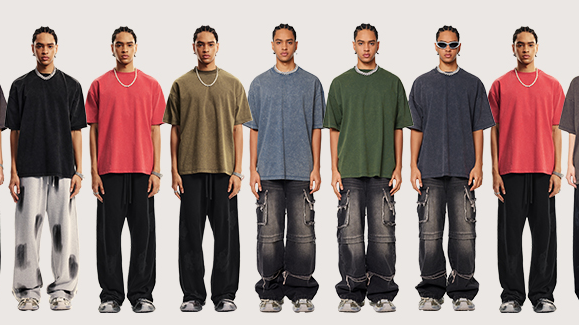Finding your footing in the saturated clothing brand market can be challenging. There are millions of brands globally making up a 1.7 trillion dollar market, all vying for different sections of a larger audience. This is why it’s essential to know who you are as a brand and who you’re selling to. Learning how to find a target market in the clothing brand industry can get you ahead of the curve in planning your successful venture.
How to Find a Target Market
If you’re starting out and have little experience in marketing and sales, you might be intimidated by the amount of terms and steps there are to answer this one question. Today we’re going through some of these ideas from a startup perspective, and which of these should matter most to you.
Buyer personas: Find a target market
You may hear the concept of buyer personas around marketing circles. This is a semi-fictional representation of the kind of customer that would buy your products. They’re not just an intuitive exercise of the imagination, but also a good way to find strategies to make your products even more appealing for these customers.
Generally speaking, a buyer persona will encapsulate these details at first:
- Demographics: What groups do your customers belong to? Gender, geography, ethnicity, age, and cultural background all account for this.
- Occupations: What jobs do they work at? The more specific is usually the better, but you can also hone in on larger industries.
- Desires and goals: What do they want in life? What do they normally do to achieve these goals? This can be as simple as acquiring wealth or gaining popularity in their social circles, or as broad as finding excitement in life or spiritual fulfillment.
Finding out answers to these questions are a mix of using hard data from your company’s sales and making assumptions based on your own industry.
For example, if you’re selling casual menswear like collared shirts or shorts, it’s a fair assumption that you’ll cater to a male demographic. From there you can make broader assumptions–what industries would your customers work in to consider your designs? What age group and cultural background would be most interested in your apparel? What do these groups gain from buying your apparel?
All of these things are the more general portions of your buyer’s persona. However, the most important parts of a buyer’s persona exist in the abstract. Let’s dissect these sections of your buyer’s persona in more detail:
Values
Everyone has their own values and principles, even if it may not be obvious at first. Knowing what kind of values your customers treasure shows you their priorities in life.
For example, the ideal buyer for a casual menswear apparel brand will likely have different values than one for formal menswear apparel. Formal menswear apparel usually suggests the customer values ideas like professionalism and ambition–after all, the people who buy suits or expensive watches will likely wear them in the office to show off their class and elegance. Meanwhile, casual menswear buyers may value comfort, convenience, and relaxation.
This is a general example, but you can apply this logic to numerous different clothing brands. This is also something that can be illuminated more by data–we’ll get into that in a bit.
Lifestyle & Interests
Values, culture, and economic situation naturally lead to how someone lives their life–in other words, their lifestyle. This is the sort of thing that can be more challenging to figure out based purely on assumptions, so you might want to do a little research on your typical buyer before deciding on it.
However, you can make some general assumptions if you’re aware of your buyer persona’s background and interests. Put yourself in the position of a 27-year-old menswear enthusiast from Singapore working as an entrepreneur, for example. Their main interest would be in fashion and styling, so how would that affect their purchasing decisions every month? What would you expect them to do on an average day, and what would they wear during those days? Who are their friends? What are their hobbies? What do their typical TikTok or Insta reel scrolls look like?
Small questions like this build a better understanding of what type of buyer you’re focusing on and how you can better cater to them.
Pain Points
Your buyer’s lifestyle will eventually lead you to their pain points. These are issues they may have in their day-to-day lives that they’d appreciate solving.
For example, a 27-year-old Singaporean entrepreneur might be thinking about how to boost their business or how to find connections to advance their current operations. A 40-year-old industrial worker in the USA with 2 kids might be thinking about how to balance their budget for the month while providing for their family. A 20-year-old college student might be looking to upgrade their style at an affordable price.
All of these details on buyers’ problems may also loop back to informing you of their values and what they look for in a new brand. Buyers with busy and career-oriented lifestyles will appreciate convenience and elegance in apparel. Others with family-oriented lifestyles may appreciate more broadly social and kid-friendly marketing and product design.
Getting data to find a target market
Making a buyer persona usually requires a lot of initial assumptions, but it’s also important to include your current customer base to that equation. Asking your current dedicated customers of their habits and lifestyles can give a decent idea on how to develop your buyer persona for future sales.
Here are some ways to get data to find a target market:
- Create a poll or survey on social media, like Insta polls. These are fun ways to package important data points into relatable engagement posts. These are more focused on lifestyle and interest questions with clear answers, like “Where do you find most of your clothes?” or “What’s your favorite musician?”
- Offer rewards for filling out a survey. This can be a voucher or gift card, or even a chance to win a few drops.
- Make engagement posts on social media. These can be funny memes or question posts, but the point is to build a conversation with your audience and gather experience.
- Ask questions after individual purchases. If you’re close enough to your buyers, you can engage with them from each purchase and see how they react. This can also give you a more personalized idea of what they find appealing about your brand.
WIth these steps, you’ll be able to find a target market for your clothing brand, and find inspiration for your next marketing schemes. Looking for more ideas on how to boost your clothing brand game? Ask our experts at Shirtual for ideas on your next clothing line and branding ideas–consultations are free!






